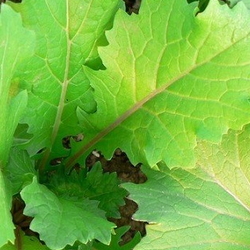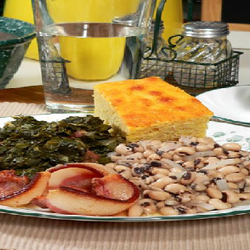I didn't realize it then, but during the years of WWII, some of us didn't have access to a variety of foods. We ate whatever we had planted and harvested, and I didn't know the difference. I grew up on beans, green beans, brown beans, white beans, canned beans, dried beans, dilly (pickled) beans, it didn't matter; because if we had nothing else, we always had beans. And potatoes: fried potatoes, boiled potatoes, mashed potatoes, scalloped potatoes, sweet potatoes, and quite often potatoes with ashes on them because they had been thrown in the fireplace to bake. I ate them raw, too, still do. We had relishes, we had stuffed peppers, we had cooked tomatoes with macaroni, we had squash and corn on the cob. And with it all, we had cornbread.
I remember the first time the family took me out to eat. I was old enough to read, so I ordered only that with which I was familiar, beans, potatoes, corn, but I suddenly realized cornbread was not on the menu. I said: "Where is the cornbread?" And the waitress said, "Well, honey, we only got rolls, and light bread, we don't serve cornbread."
No cornbread? Well I decided then and there that I would not be eating in their fine establishment. I was about six at the time, and already had a mind of my own, and there was no way I could eat any of those foods without cornbread. It just wasn't right. So I said: "Those foods ain't no good without cornbread, so I'm not eatin' nothing". And my mother said: "Don't say ain't, say isn't". We were in Lexington and had to talk right in the big city. Mom didn't get it. I was not going to eat, using ain't or isn't just didn't matter. The waitress brought beans and corn for me, since the choice was only two vegetables and not three. I did not eat either of them, I had to have cornbread. My parents were embarrassed and angry, I could tell, but I would not eat. I sat quietly, and moved my beans and corn around on the plate so that I had a big yellow flower with big green leaves right in the middle of my plate, but I didn't eat.
I don't remember the rest of the story, but I do know I went to bed without my cornbread or any other thing to eat that night. That lesson learned, I decided I would learn to bake my own cornbread and carry it with me the next time we went to a restaurant, just in case the establishment did not serve cornbread. I asked Granny Ninna to teach me.
There I was, standing on a three legged stepstool, belly up to the part of the kitchen sink that had counter space on it. Ninna measured out meal, then flour, baking soda, baking powder, salt, an egg and some buttermilk. She put bacon grease in one of her cast iron skillets and put it in the oven to heat. I mixed and stirred, one ingredient at a time, while the skillet heated. When the bacon grease started popping in the skillet, Ninna took it out of the oven, and she poured most of the grease into my cornbread batter. I stirred again, while the batter fizzled and popped a little, then she poured the mixture into the skillet, and placed it in the oven. It was a success!! I could bake my own cornbread...as long as somebody else handled the skillet with its hot grease. I considered this a survival skill of my own. I could not survive without cornbread.
Cornbread in some form has been around since the Native Americans roamed this land. If there was corn growing, cornbread was sure to follow. Aunt Bett told me that the first cornbread was made by our ancestors by grinding their own corn into meal, and grinding it a little more into flour. They only moistened it with eggs at that time, whatever eggs were available, and then baked it into a thin, dense, flat bread that was easy to transport for long distances over a long period of time.
In the south, cornbread is made in much the same way as it always has been, just as Ninna taught me, but my northern relatives tell me that it must contain sugar. Trust me, true cornbread cannot contain suger, because if it does, you just might as well add a little honey and have it for dessert. Sweet cornbread just doesn't fit a regular dinner menu of beans, corn and potatoes. Funny how tastes develop, isn't it? If you prefer sweet cornbread, then by all means, go for it, and thanks, but I don't believe I really want to share it with you.
Cornbread has many uses, depending on where you live. Some in the south like it crumbled into a glass of cold buttermilk and eaten with a spoon. It is eaten with barbeque and chili. It is stirred into pinto beans (called soup beans where I grew up) and eaten for lunch or as a side dish with supper. Cornbread crumbs are used to stuff poultry, particularly at Thanksgiving and Christmas meals. In the United States, I find that northern cooks tend to use yellow corn meal, but most often southern cooks prefer white. And of course, the north prefers it sweet, and the south doesn't. And yet in Texas, with the Mexican influence, a hearty cornbread is made with fresh or creamed corn kernels, jalapeno peppers, chopped onions and topped with cheese. That particular recipe is what I always serve with chili.
I have an aunt who was raised in southeast Kentucky, just as I was. She moved to central Indiana back in the late 40's when I was still very small. I like to tease her now because whenever I visit, we argue about her "Yankee Cornbread". Her recipe contains half wheat flour, half cornmeal, milk, eggs, salt, and usually sugar. I tell her she has traded sides. But I will have to admit her cornbread is lighter and definitely sweeter than mine is. I eat it anyway, just because we enjoy arguing about it. Sometimes this is known as "light cornbread" here in western Kentucky, since we are just south of several states that are considered northern.
Here are some cornbread ideas:
Cornpone: a type of cornbread made with a thick, malleable dough made of cornmeal and/or hominy grits, shaped by hand and then baked or fried in butter, margarine, lard or bacon grease. The term "cornpone" comes from the Algonquin tribe.
Hot water cornbread: a type of cornbread that is cooked on the top of the stove involving a small amount of liquid batter made with boiling water and self rising cornmeal, added into a skillet of hot oil, and allowing the crust to turn golden and crunchy, while the center of the batter cooks into a crumbly and mushy bread.
Johnnycake: pouring thin batter into hot grease in a skillet produces a sort of pancake like bread. Some think the term is from "journey" cake, often prepared by travelers.
Hushpuppies...Yummmm: A thicker buttermilk-based batter which is deep fried rather than pan fried. Recipes vary from family to family, but most include chopped onions. The hushpuppy will be moist in the center and crunchy dark brown on the outside. That name probably comes from ages ago when leftover bits of batter were tossed together into hot grease then fed to hungry dogs who were looking for a handout. Hushpuppies are wonderful with a fish dinner.
Now, if you are considering baking cornbread, there are two more things you might want to know. To bake good cornbread, you must have a properly cured cast iron skillet. Cornbread is important, so I have one skillet that I use only for cornbread. I have had it for probably 40 years, and wherever I go, it goes, if I am going to be baking cornbread. A nine inch skillet is about the right size. If it is new, it should be washed and dried thoroughly, then lightly basted all over, including the handle, with vegetable oil. Just a very light covering will do, and then it must be placed in a preheated 200 degree oven for several hours. Check periodically to see if any of the oil has dried on the skillet, and if it has then brush a little more on it. When the process is finished, it should then be a light brown. With use, a properly cured skillet will develop a black sheen.
Your skillet should never be used for anything except baking cornbread, and it should never again be washed in detergent. After each use, clean it thoroughly with dry paper towels, and store in a dry place. Before each use then, oil the inside surface thoroughly. Preheat the skillet because the cornbread batter should only be added to a hot skillet.
And here is the second thing you need to know: The Great Cornbread Recipe.
If you ask a dozen different southern cooks how they make cornbread, you will get that many different answers. But there is one ingredient that no southern cook will ever use, and that is sugar. (Unless of course, that southern cook was transplanted from the north.) Always use buttermilk, and that directive comes straight from my Granny Ninna. It does make a difference in flavor. My grandmothers and older relatives used cornmeal straight from the mill, when the corn dried, it was taken directly up the road where one of our neighbors had a make shift grinding mill. The corn of course had been planted and tended, then harvested by Aunt Bett and Ninna. Today we most often use the self rising brands that come from the grocery stores, and that makes it more convenient, but does alter the flavor and texture somewhat.
Here is my favorite, and I have allowed for modern convenience just for you:
2 cups of self rising cornmeal
2 beaten eggs
2 cups of buttermilk
2 Tablespoons bacon drippings, melted in iron skillet while the oven preheats
Heat oven to 450 degrees, grease your skillet with bacon drippings, and leave some of the drippings in the bottom of pan to melt.
Combine cornmeal, 2 eggs, buttermilk and then mix well. When the bacon grease is sizzling in the oven, add it to the mixture, and again mix well.
Pour into hot skillet, and batter will sizzle as it is being poured.
Bake at 450 for about 35 minutes or until golden brown. This will serve 6 to 8, unless I am there eating with you, in which case, you should not expect it to serve that many.
Just a hint here: I usually sprinkle a little cornmeal in the hot pan before adding the batter, it will brown and add a bit of crispiness to the texture.
And one more hint: If you use plain cornmeal, add 2 teaspoons of baking powder and just a pinch of salt for each cup of regular meal. It doesn't hurt to sprinkle a dash of baking flour into the mix either, to add a bit of cohesion to the cornbread.
The interesting thing about cornbread is that the cornmeal contains its own leavening agent, and will rise slightly on its own, without the use of yeast or other leavening agents.
There you have it, the easiest way to make southern cornbread. I will have to admit that I do have a few burn scars from the old cookstove, and there were a few disastrous pieces of hard burned cornbread along the way, but over the years I have learned to make really good cornbread. When I am invited to a potluck, usually I am asked to bring my cornbread with me, and when that happens I think that Granny Ninna might be smiling.
The thumbnail photo is from Wikipedia's Public Domain images as is the photo of yellow meal cornbread. The collages are my own.

















